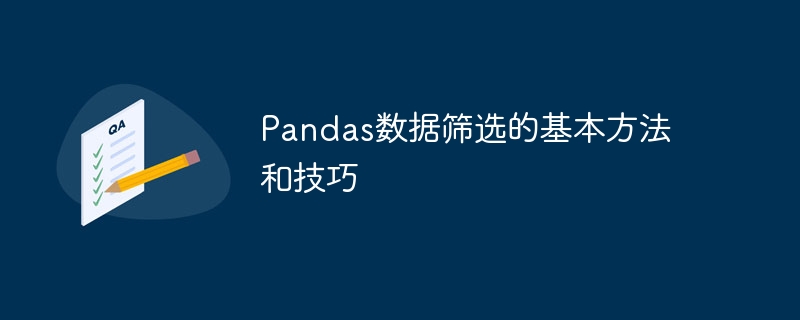Home >Backend Development >Python Tutorial >Basic Pandas data filtering methods and techniques
Basic Pandas data filtering methods and techniques
- WBOYWBOYWBOYWBOYWBOYWBOYWBOYWBOYWBOYWBOYWBOYWBOYWBOriginal
- 2024-01-24 09:11:201565browse

Basic methods and techniques for Pandas data filtering, specific code examples are required
Introduction:
With the continuous development of data analysis and processing, Pandas has become A great tool for data scientists and analysts. Pandas is an open source data analysis library based on NumPy, which provides a flexible and efficient data structure suitable for data reading, cleaning, analysis and visualization. In the data analysis process, data filtering is a very important link. This article will introduce the basic methods and techniques of Pandas data filtering, and provide specific code examples to help readers better understand and apply.
1. Review of Pandas data structure
Before starting specific data screening, let’s first review the main data structures of Pandas - Series and DataFrame.
1.1 Series
Series is an object similar to a one-dimensional array, consisting of a set of data and indexes. Data can be of any type, and an index is a label that helps us locate and access data. We can create a Series in the following way:
import pandas as pd data = pd.Series([1, 2, 3, 4, 5])
1.2 DataFrame
DataFrame is the most commonly used data structure in Pandas and can be viewed as an object similar to a two-dimensional array or table. It consists of an ordered set of columns, each of which can be of a different data type (integer, float, string, etc.). We can create a DataFrame in the following ways:
data = {'Name': ['Tom', 'John', 'Amy', 'Lisa'],
'Age': [25, 30, 28, 35],
'City': ['Beijing', 'Shanghai', 'Guangzhou', 'Shenzhen']}
df = pd.DataFrame(data) 2. Pandas data filtering methods and techniques
Pandas provides a wealth of data filtering methods and techniques. Below we will introduce some commonly used methods.
2.1 Basic condition filtering
Filtering by specified conditions is one of the most common data filtering methods. Pandas provides functionality similar to the WHERE keyword in SQL. We can use comparison operators (==, !=, >, =,
# 筛选年龄大于等于30的数据 df[df['Age'] >= 30]
2.2 Multi-condition filtering
In addition to filtering by a single condition, we can also combine multiple conditions for filtering through logical operators (and, or, not) and parentheses. An example is as follows:
# 筛选年龄大于等于30并且城市为上海的数据 df[(df['Age'] >= 30) & (df['City'] == 'Shanghai')]
2.3 isin() function filtering
The isin() function is a very useful filtering method, which can help us filter out data that meets certain conditions. An example is as follows:
# 筛选城市为上海或深圳的数据 df[df['City'].isin(['Shanghai', 'Shenzhen'])]
2.4 query() function filtering
query() function is an advanced filtering method provided by Pandas, which can implement complex data filtering in one line of code. An example is as follows:
# 使用query()函数筛选年龄大于等于30的数据
df.query('Age >= 30')2.5 Filter by column name
Sometimes we only need to filter out data in certain columns, and we can filter by specifying column names. An example is as follows:
# 筛选出名字和城市两列的数据 df[['Name', 'City']]
2.6 Use loc and iloc for filtering
In addition to the above methods, Pandas also provides two special attributes, loc and iloc, for data filtering. loc is used for indexing based on label, while iloc is used for indexing based on position. An example is as follows:
# 使用loc基于标签进行筛选 df.loc[df['Age'] >= 30, ['Name', 'City']] # 使用iloc基于位置进行筛选 df.iloc[df['Age'] >= 30, [0, 2]]
3. Summary
This article introduces the basic methods and techniques of Pandas data filtering, and provides specific code examples. By mastering these methods, we can flexibly filter and process data to extract the information we need. In addition to the above methods, Pandas also provides many other powerful functions and tools for further learning and exploration based on actual needs. I hope this article will be helpful to readers in data screening and enable them to better utilize Pandas for data analysis and processing in practical applications.
The above is the detailed content of Basic Pandas data filtering methods and techniques. For more information, please follow other related articles on the PHP Chinese website!
Related articles
See more- Methods of DataFrame type data operation functions in python pandas
- What are the basic methods for optimizing the website using Dreamweaver CMS system?
- Detailed explanation of the process and basic methods of GitLab automated deployment
- What are the methods for operating Pandas files and reading CSV parameters in Python?

